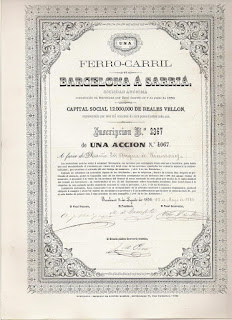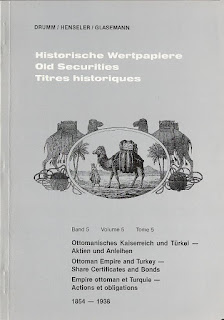The 1896 share certificate of the newspaper Le Petit Journal shows a sou in the lower border. France counted about 40 million people around that time. In that single year more than 6 million pieces of this 5 Centimes coin were minted. Being in circulation all over France for decades and representing a little value, this sou just seemed to be an unimportant and common coin. However, the French people used it buy a newspaper that brought the world into their lives.
The sou, or 5 Centimes coin
Millaud
Moïse Polydore Millaud would revolutionize the newspaper business when forming Le Petit Journal. This newspaper, with its offices at the Paris Opera, was published from 1863 to 1944. Right from the beginning, Millaud’s main objective was achieving a circulation as high as possible. By 1877 the circulation was increased to 500.000. A weekly illustrated supplement was included in 1884.
Share certificate of Le Petit Journal
Action de 500 Francs, 1896
Design by Meyer and engraving by Meaulle
The sou appears in the design of the lower border,
but also twice in the underprint (click image for more details).
Sensation and clever marketing
In order to achieve his goals, Millaud wanted his newspaper to be different than the others. His newspaper focused not on the usual political topics but on faits divers, crime stories, international issues, war and sensations. Millaud sent his reporters out into the street to learn from the public opinion. By avoiding publication of political news Millaud also escaped the 10 Centimes tax imposed on political newspapers. Serial novels and articles were published in the newspaper in order to entice readers to buy the next edition. After Millaud’s death in 1871, first Emile de Gerardin and later in 1882, Hippolyte Marinoni took over the company. Marinoni was not only an expert in printing mechanisation, he was also a true newspaper manager.
The illustrated supplement of Sep 6th 1896
source : Gallica, the digital library of the Bibliothèque Nationale de France
In 1887 Marinoni assigned Pierre Giffard the task for reorganizing the newsroom. Giffard introduced a succesful diary under the pseudonym Jean-sans-Terre. Giffard was also the man who started organizing public stunts and promotional events on behalf of the newspaper:
1891, the Paris-Brest first long-distance cycle race
1892, the Paris-Belfort 380 km running race
1894, the world’s first motor-race Paris-Rouen
1896, the Paris Marathon at the inaugural Olympics
To each event, Le Petit Journal dedicated a series of articles. The French public followed the races and its participants in the editions covering them. Circulation rose steadily.
The entry of the offices of Le Petit Journal depicted
in the upper border of the certificate (left) and
on the frontpage of the Illustrated Supplement of June 18th 1892 (right).
Click to enlarge
5 Centimes
Bringing news that sells is one thing, but getting the readers to buy your newspaper is something else. Millaud realized that the price for his newspaper had to be low. Buy setting its price to 5 Centimes, he made Le Petit Journal affordable to a nationwide audience.
In fact, the price setting was a key factor in the marketing strategy. The sou was incorporated in the share design of Le Petit Journal. Between 1871 and 1898 almost 73 million pieces of this coin were struck, including all varieties.
Obverse : head of Cérès, REPUBLIQUE FRANCAISE
Reverse: 5 CENTIMES, LIBERTE EGALITE FRATERNITE
The coin was designed by Eugène Oudiné (1810-1887). Oudiné was a French sculptor and one of the best known engravers of medals and coins. In 1831 he won the grand prize for medal engraving and became designer at the French Mint. He also engraved coins for other countries like Argentina.
Innovation
The newspaper needed to be printed in large quantities, on both sides, with color pages and at a very low cost. Hippolyte Marinoni (1823-1904) made this technically possible.
facsimilé signature of Hippolyte Marinoni
His career starts at Gaveaux, a manufacturer of typographical machines. In 1847 Marinoni constructs a press with 2 cylinders and 3 years later he assists Jacob Worms, a German immigrant, with the development of a rotary press. Marinoni starts his own business and constructs a lithography machine. In 1860 he helps Etienne Lenoir developing the Lenoir gas engine. Six years later, Marinoni patents a rotary printing press in which the images to be printed are curved around a cylinder. In 1872 his rotation press is installed at the newspaper La Liberté, the first rotation press in France. After that , five of these are installed at Le Petit Journal. Marinoni sees the importance of color printing. In 1889 he develops a color rotation press.
Marinoni rotation press
Pioneer
By bringing sensational news, applying clever customer binding techniques, and a newspaper that could be sold for the price of 5 Centimes, it is no wonder that Le Petit Journal was succesfull. In the 1890s, circulation rose to a million copies per day. Le Petit Journal is now recognized as a pioneer of the sensation press and mass media.
Luckily, many of these lovely designed share certificates have survived the past 114 years. You should be able to find them at a reasonable price at several scripophily dealers. I purchased mine in Paris at one of the “bouquinistes”, the book stalls along the banks of the Seine river.
Other issues of this type with different colors or denominations exist. If you would know of any previously issued certificates of this company, please tell me in the comments below.
F.L.
Some links:


















































